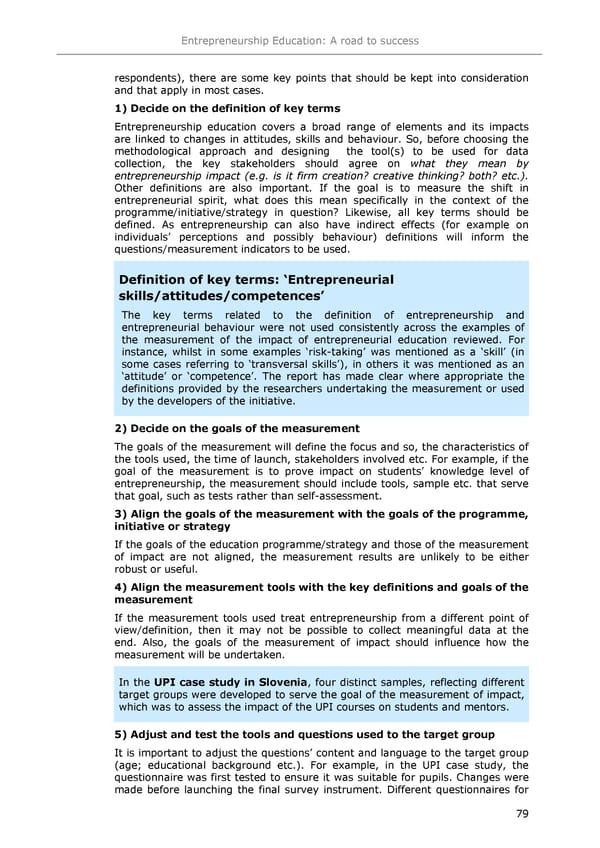Entrepreneurship Education: A road to success respondents), there are some key points that should be kept into consideration and that apply in most cases. 1) Decide on the definition of key terms Entrepreneurship education covers a broad range of elements and its impacts are linked to changes in attitudes, skills and behaviour. So, before choosing the methodological approach and designing the tool(s) to be used for data collection, the key stakeholders should agree on what they mean by entrepreneurship impact (e.g. is it firm creation? creative thinking? both? etc.). Other definitions are also important. If the goal is to measure the shift in entrepreneurial spirit, what does this mean specifically in the context of the programme/initiative/strategy in question? Likewise, all key terms should be defined. As entrepreneurship can also have indirect effects (for example on individuals9 perceptions and possibly behaviour) definitions will inform the questions/measurement indicators to be used. Definition of key terms: 8Entrepreneurial skills/attitudes/competences9 The key terms related to the definition of entrepreneurship and entrepreneurial behaviour were not used consistently across the examples of the measurement of the impact of entrepreneurial education reviewed. For instance, whilst in some examples 8risk-taking9 was mentioned as a 8skill9 (in some cases referring to 8transversal skills9), in others it was mentioned as an 8attitude9 or 8competence9. The report has made clear where appropriate the definitions provided by the researchers undertaking the measurement or used by the developers of the initiative. 2) Decide on the goals of the measurement The goals of the measurement will define the focus and so, the characteristics of the tools used, the time of launch, stakeholders involved etc. For example, if the goal of the measurement is to prove impact on students9 knowledge level of entrepreneurship, the measurement should include tools, sample etc. that serve that goal, such as tests rather than self-assessment. 3) Align the goals of the measurement with the goals of the programme, initiative or strategy If the goals of the education programme/strategy and those of the measurement of impact are not aligned, the measurement results are unlikely to be either robust or useful. 4) Align the measurement tools with the key definitions and goals of the measurement If the measurement tools used treat entrepreneurship from a different point of view/definition, then it may not be possible to collect meaningful data at the end. Also, the goals of the measurement of impact should influence how the measurement will be undertaken. In the UPI case study in Slovenia, four distinct samples, reflecting different target groups were developed to serve the goal of the measurement of impact, which was to assess the impact of the UPI courses on students and mentors. 5) Adjust and test the tools and questions used to the target group It is important to adjust the questions9 content and language to the target group (age; educational background etc.). For example, in the UPI case study, the questionnaire was first tested to ensure it was suitable for pupils. Changes were made before launching the final survey instrument. Different questionnaires for 79
 Entrepreneurship Education Page 82 Page 84
Entrepreneurship Education Page 82 Page 84